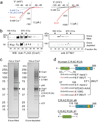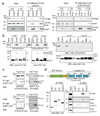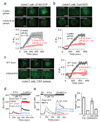A novel EF-hand protein, CRACR2A, is a cytosolic Ca2+ sensor that stabilizes CRAC channels in T cells
- PMID: 20418871
- PMCID: PMC2875865
- DOI: 10.1038/ncb2045
A novel EF-hand protein, CRACR2A, is a cytosolic Ca2+ sensor that stabilizes CRAC channels in T cells
Abstract
Orai1 and STIM1 are critical components of Ca(2+) release-activated Ca(2+) (CRAC) channels that mediate store-operated Ca(2+) entry (SOCE) in immune cells. Although it is known that Orai1 and STIM1 co-cluster and physically interact to mediate SOCE, the cytoplasmic machinery modulating these functions remains poorly understood. We sought to find modulators of Orai1 and STIM1 using affinity protein purification and identified a novel EF-hand protein, CRACR2A (also called CRAC regulator 2A, EFCAB4B or FLJ33805). We show that CRACR2A interacts directly with Orai1 and STIM1, forming a ternary complex that dissociates at elevated Ca(2+) concentrations. Studies using knockdown mediated by small interfering RNA (siRNA) and mutagenesis show that CRACR2A is important for clustering of Orai1 and STIM1 upon store depletion. Expression of an EF-hand mutant of CRACR2A enhanced STIM1 clustering, elevated cytoplasmic Ca(2+) and induced cell death, suggesting its active interaction with CRAC channels. These observations implicate CRACR2A, a novel Ca(2+) binding protein that is highly expressed in T cells and conserved in vertebrates, as a key regulator of CRAC channel-mediated SOCE.
Figures







Comment in
-
Cracking CRAC.Nat Cell Biol. 2010 May;12(5):416-8. doi: 10.1038/ncb0510-416. Nat Cell Biol. 2010. PMID: 20442700 Free PMC article.
References
-
- Feske S. Calcium signalling in lymphocyte activation and disease. Nat Rev Immunol. 2007;7:690–702. - PubMed
-
- Gwack Y, Feske S, Srikanth S, Hogan PG, Rao A. Signalling to transcription: store-operated Ca2+ entry and NFAT activation in lymphocytes. Cell Calcium. 2007;42:145–156. - PubMed
-
- Lewis RS. Calcium signaling mechanisms in T lymphocytes. Annu Rev Immunol. 2001;19:497–521. - PubMed
Publication types
MeSH terms
Substances
Associated data
- Actions
Grants and funding
LinkOut - more resources
Full Text Sources
Other Literature Sources
Molecular Biology Databases
Research Materials
Miscellaneous

